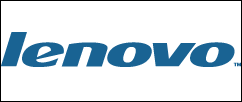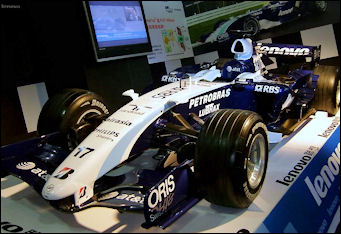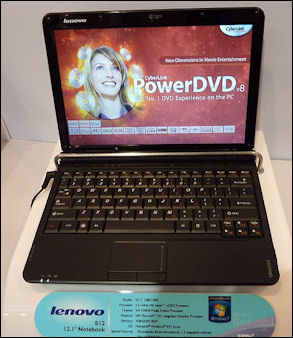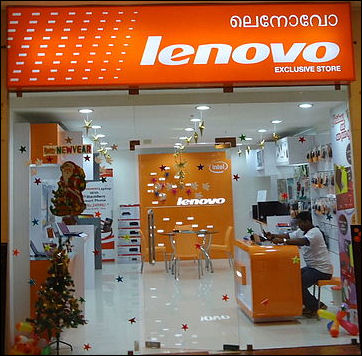LENOVO

Lenovo is the world's largest personal computer vendor by unit sales as of 2021. Official known as Lenovo Group Limited, it is a Chinese multinational technology company that manufacturesdesktop computers, laptops, tablet computers, smartphones, workstations, servers, supercomputers, electronic storage devices, IT management software, and smart televisions. Its best-known brand in the West is IBM's ThinkPad business line of laptop computers. It also makes the IdeaPad, Yoga, and Legion consumer lines of laptop computers, and the IdeaCentre and ThinkCentre lines of desktop computers. In 2022, Lenovo’s revenues US$71.6 billion, with an operating income of US$3.1 billion and a net income of US$2.1 billion. Its total assets in 2022 were US$44.51 billion and its total equity was US$5.395 billion. That year the company had 75.000 employees. [Source: Wikipedia]
Formally known as Legend, Lenovo is based in Beijing and listed on the Hong Kong Stock exchange. Partly owned by the Chinese government, it was founded in Beijing in 1984 by researchers with from a science academy and got its start as a distributor for personal computers for IBM, Hewlett Packard and the Taiwanese PC maker AST in China. In 1997 it surpassed IBM to become the largest seller of personal computers in China. It had $3 billion in sales in 2003, selling PC for as little as $360 and having a large share of sales in the government and in schools. That year 89 percent of its revenues came from China. Lenovo has expanded aggressively outside China since it became a global brand by acquiring IBM’s PC unit in 2005. In 2010 Lenovo was China’s largest computer maker and the third largest computer company in the world behind Dell and Hewlett Packard. At that time it sold one third of the branded computers sold in China and made computers and computer parts for a number of foreign companies. It was valued at $15 billion in 2007.
Lenovo has headquarters in Hong Kong Beijing and in the U.S in Morrisville, North Carolina. Yang Yuanqing is the chairman and CEO. Liu Chuanzhi is the former CEO of Lenovo as well as its founder. A former government scientist who spent three years at a labor camp during the Cultural Revolution, founded the business with a $24,000 loan from the government while he was a scientist at the Chinese Academy of Science. Lenovo was the first company to sign up as a sponsor for the 2008 Olympics in Beijing. It reportedly paid $65 million for a sponsorship deal involving the 2006 Olympics in Turin and the 2008 Olympics in Beijing that includes providing computer equipment and services for both Olympics.
Lenovo is well entrenched in China and is regarded as one of China’s most trusted brands. As of 2007, it had 35 percent market share of the Chinese PC market and sold it products at more than 9,000 retail outlets. It has been able to out-compete foreign rivals such as Dell and IBM in China partly because it doesn't have to pay the tariffs foreign companies pay. Its market share in China shrunk after China joined the WTO as Dell and Hewlett Packard made inroads into the Chinese market.
RECOMMENDED BOOKS: “The Lenovo Way: Managing a Diverse Global Company for Optimal Performance” by Gina Qiao, Yolanda Conyers, et al. Amazon.com; “Tech Titans of China: How China's Tech Sector Is Challenging the World by Innovating Faster, Working Harder, and Going Global” by Rebecca A. Fannin, Janet Metzger, et al. Amazon.com; “Factory Girls: From Village to City in a Changing China” by Leslie T. Chang, Susan Ericksen, et al. Amazon.com; “The Great U.S.-China Tech War” by Gordon G. Chang, Al Kessel, et al. (2020) Amazon.com; “China's Leap into the Information Age: Innovation and Organization in the Computer Industry” by Qiwen Lu (2000) Amazon.com; “Marketing Dictatorship” by Anne-Marie Brady Amazon.com; “The Transpacific Experiment: How China and California Collaborate and Compete for Our Future” by Matt Sheehan Amazon.com
Lenovo’s Strategy

Lenovo F1 Car After spending the years focusing on expanding sales, Lenovo changed its strategy in the early 2010s to give equal emphasis to profits. CEO Yang Yuanqing said in August 2011. "We will continue to invest in capturing growth in emerging markets while focusing on improving profitability," Yang said. [Source: AP, May 28, 2011]
Lenovo was the only Chinese company that was a major sponsor of the Olympics. It was a co-sponsor of the torch relay and designed the striking scroll-like Olympics torch. It also provided more than 10,000 pieces of computing equipment and 500 engineers to help deliver data and results from more than 300 events to the media and audiences around the world. Lenovo was one of twelve 2008 Summer Olympic Games worldwide partners that has marketing rights to use the Olympics logo globally. It also is a major sponsor in Formula One racing.
In 2011 Lenovo expanded in developed markets with an acquisition this year in Germany and a joint venture in Japan. In June Lenovo announced its acquisition of Germany's Medion AG, a maker of multimedia products and consumer electronics, a move that would make it the second-largest PC vendor in Europe's biggest computer market. Lenovo launched a joint venture with Japan's NEC Corp., expanding its presence in the Japanese market.
Lenovo and IBM
In December 2004, Lenovo Group’s bought a majority stake in the personal and laptop computer business of IBM for $1.75 billion, a relatively modest price It was one of the largest Chinese overseas takeover deals ever. The move quadrupled Lenovo’s sales and made it the third largest computer company in the world. Before the deal Lenovo was the 8th largest computer company in the world. Much of the deal was worked out by a woman, Mary Ma, Lenovo’s chef negotiator and chief financial officer. Lenovo is the world’s third largest personal computer maker. Lenovo wasn't the first Chinese company to acquire a big foreign brand, but it's still considered the pioneer.
The move improved Lenovo’s name recognition. Lenovo was able to freely use the IBM and Thinkpad names until 2010. After the acquisition Li said, “This acquisition will allow Chinese industry to make significant inroads on the path of globalization. IBM’s PC business operated factories in Raleigh, North Carolina and employs 10,000 people worldwide, with 40 percent of them already working in China. The entire company has 319,000 employees.
In the deal Lenovo obtained IBM’s desktop PC business, including research, development and manufacturing for $1.25 billion in cash and shares while IBM retains a 18.9 percent stake in the company. Including $500 million in liabilities Lenovo agreed at assume the total value of the deal was $1.75 billion. Lenovo moved its worldwide headquarters to New York. Its chief executive officer is Stephen Ward Jr., an IBM senior vice president. IBM held on to mainframe business and planned to focus on consulting, services and outsourcing.
IBM had want to unload its PC business for some time. It was a drain n the company’s resources. There were some worries the deal might be scuttled by U.S. regulators over national security concerns. There were other worries about the deal. including Lenovo’s lack of experience on the international markets and the weakness of IBM’s PC division, which often posted losses.
Lenovo After the IBM Deal

The IBM deal boosted Lenovo’s global share to 7.7 percent, compared to 19.1 percent for Dell and 16.1 percent for Hewlett Packard. With IBM, Lenovo is the fifth largest company in China with sales of $12.5 billion, including $9.5 billion from IBM, in 2003. It has a 30 percent share of the computer market in China in 2006 It is 28 percent owned by the Chinese government and 13 percent owned by IBM.
Lenovo’s United States headquarters is in Morrisville near Raleigh, North Carolina. It Asian operations and most its manufacturing is in China. The company also has hubs in Singapore, Paris, Japan and India but no official headquarters. Executive meetings are held 10 to 12 times a years in cities around the globe.
A short time after the IBM deal it hired four of Dell’s top executives. Lenovo’s CEO (2007) is former Dell executive William Amelio. He is based in Singapore. The chairman is Yang Yuanqing who is based in North Carolina. Many top executive are based in Purchase, New York and North Carolina. Much of the research and development is done in China.
Lenovo relied more heavily on the higher-margin corporate market than its main rivals and was hit hard when companies slashed spending following the 2008 global financial crisis. Lenovo responded to the crisis by following the lead of an increasing number of Chinese firms: returning to its roots. Yuan Yuanqing was reappointed its chief executive and refocused Lenovo on the company's one bright spot: the China market. Sales skyrocketed, despite lackluster performance overseas. Lenovo, according to Bob O'Donnell, a longtime expert on personal computers at IDC, "became a Chinese company again."
Lenovo's After Its Purchase of IBM
John Pomfret wrote in the Washington Post,”Lenovo wasn't the first Chinese company to acquire a big foreign brand, but it's still considered the pioneer. That's probably because China's other forays into buying foreign brands have ended in disaster. An attempt by the Chinese electronics firm TCL to become the world's biggest TV manufacturer in 2003 fizzled when its French subsidiary lost $250 million. A move by a private Chinese company to take over a once-dominant U.S. lawn mower company, Murray Outdoor Power Equipment, ended in bankruptcy because, among other mistakes, the Chinese firm didn't realize that Americans tend to buy mowers mostly in the spring. [Source: John Pomfret, Washington Post, Tuesday, May 25, 2010]
Lenovo purchased IBM's laptop division for $1.25 billion — a gutsy move considering that IBM's renowned ThinkPad brand lost $1 billion from 2000-2004, twice Lenovo's total profit during that time. Although Lenovo's move was portrayed by many in the West as a sign of China's rise, Lenovo acted out of desperation, said Yang Yuanqing, who has been a senior executive at Lenovo since it was founded in the 1980s with government funds. Lenovo was losing market share in China. Its technology was middling. It had no access to foreign markets. With one swoop, Lenovo internationalized, purchased a famous brand and got a warehouse of technology as well.
Chinese officials pushing the going-out strategy have looked at Lenovo as a model for Chinese firms seeking to become known multinational brands. But for China's companies, going out might be the secret to staying alive at home. Analysts said Lenovo's rocky foreign adventure saved the company. Lenovo might not have much of a brand overseas, but its association with a foreign firm has helped it in China. Lenovo's computers routinely command twice the price in China that they do in the United States. Lenovo offers its top-of-the-line ThinkPad W700 to the Chinese government at $12,500; in the United States, it runs for $2,500.

After the IBM purchase, Pomfret wrote,"things were tough. Lenovo's American competitors fanned anti-Chinese flames in Congress, insinuating that Lenovo could insert spyware into the computers it was selling to the U.S. government. The firm also faced enormous challenges bridging cultural divides among U.S. workers at its Raleigh, N.C., headquarters, the Japanese who made ThinkPads and the Chinese who made Lenovos.
William Amelio, the firm's second chief executive who had been lured from a top job at Dell, remembers his first trip to Beijing as the new Lenovo boss in late 2005. "I was greeted with rose petals and the red carpet treatment and company songs. In Raleigh, everyone's armed were crossed. It was like, 'Who died and left you the boss?' " he said. "You had the respect for power in the East and the disdain for authority in the West." Meanwhile, Lenovo's competitors were moving. In 2007, Acer, the computer powerhouse from Taiwan, snapped up the European computer maker Gateway, effectively cutting Lenovo off from European customers. Lenovo slipped to fourth place worldwide behind HP, Dell and Acer.
Lenovo Growth in the Early 2010s
By 2012, had picked up for Lenovo. That year, according Gartner consultancy group, Lenovo surpassed Hewlett-Packard as the world’s biggest seller of PCs. According to The Economist: Its mobile division is poised to leapfrog Samsung to grab the top spot in China, the world’s biggest smartphone market. This week it made a splash at the International Consumer Electronics Show in Las Vegas with what PC World called “bullish bravado and a seemingly bottomless trunk” of enticing new products.
“Lenovo’s recovery owes much to a risky strategy, dubbed “Protect and Attack”, embraced by the firm’s current boss. After taking over in 2009, Yang Yuanqing moved swiftly. Keen to trim the bloat he inherited from IBM, Mr Yang cut a tenth of the workforce. He then acted to protect its two huge profit centres—corporate PC sales and the China market—even as he attacked new markets with new products. When Lenovo bought IBM’s corporate PC business, it was rumoured to be a money-loser. Some whispered that Chinese ineptitude would sink IBM’s well-regarded Think PC brand. Not so: shipments have doubled since the deal, and operating margins are thought to be above 5 percent.
“An even bigger profit centre is Lenovo’s China business, which accounts for some 45 percent of total revenues. Amar Babu, who runs Lenovo’s Indian business, thinks the firm’s strategy in China offers lessons for other emerging markets. It has a vast distribution network, which aims to put a PC shop within 50km (30 miles) of nearly every consumer. It has cultivated close relationships with its distributors, who are granted exclusive territorial rights. Mr Babu has copied this approach in India, tweaking it slightly. In China, the exclusivity for retail distributors is two-way: the firm sells only to them, and they sell only Lenovo kit. But because the brand was still unproven in India, retailers refused to grant the firm exclusivity, so Mr Babu agreed to one-way exclusivity. His firm will sell only to a given retailer in a region, but allows them to sell rival products.
Lenovo’s Efforts to Expand

Lenovo entered wireless Internet in 2010 and has launched smartphones and Web-linked tablet computers in competition with Apple, South Korea's Samsung Electronics and Taiwan's HTC. It unveiled a low-priced smartphone in August 2011 to target developing markets.
Lenovo’s aim has long been to become a major global brand. It has introduced new products, built a worldwide distribution system and has spent a lot of money, including $50 million to be a top-tier sponsor at the Beijing Olympics, to gets its name and brand recognized. In the United States, it is expanding sales outlets and charging lower prices than its rivals with desktops for as little as $350. In India, it is using Bollywood stars to advertise its products. Company CEO Yang Yuanqing told AP, “We went from a company that operated solely in China to a company with operations around the world. The Lenovo, which was unknown outside of China before, is now known to more and more people around the world.”
Lenovo has sold computers to the U.S. State Department, including branches that deal with classified materials. There is some concern in the United States that the computers could be rigged in a way so they could provide classified materials to the Chinese government. In 2015 The U.S. government on Friday advised Lenovo Group Ltd customers to remove a "Superfish," a program pre-installed on some Lenovo laptops, saying it makes users vulnerable to cyberattacks Superfish was a California-based company.
Lenovo had to navigates a PC market that shrunk markedly in the 2010s after the advent of tablet computers. It mobile business accounted for 18 percent of revenue in 2017 but often struggled Lenovo acquired the troubled Motorola handset business from Google for US$3 billion in 2014. Lenovo said that one of the reasons it bought the division was to take advantage of Motorola's existing relationships with network operators in North America and Europe buts its goald didn’t meet expectation. In 2016 sales were high India and Latin America but Lenovo lost money on every handset it sold. Competition was stiff in the mobile and mart phone markets as Chinese brands such as Oppo, Huawei, ZTE and Xiaomi aggressively competed in China and just as aggressively expanding into markets outside China, where they competed against Samsung and Apple.
How Lenovo Is Different From Other Chinese Companies

at a souk in the Middle East
The Economist reported: “Lenovo started humbly. Its founders established the Chinese technology firm at an early meetings in a guard shack. It did well selling personal computers in China, but stumbled abroad. Its acquisition of IBM’s PC business in 2005 led, according to one insider, “to nearly complete organ rejection.” Gobbling up an entity double its size was never going to be easy. But cultural differences made it trickier. IBMers chafed at Chinese practices such as mandatory exercise breaks and public shaming of latecomers to meetings. Chinese staff, said a Lenovo executive at the time, marvelled that: “Americans like to talk; Chinese people like to listen. At first we wondered why they kept talking when they had nothing to say.” [Source: The Economist, January 12, 2013]
“Lenovo’s culture is different from that of other Chinese firms. A state think-tank, the Chinese Academy of Sciences, provided the original $25,000 seed capital, and still owns an indirect stake. But those in the know say Lenovo is run as a private firm, with little or no official interference. Some credit must go to Liu Chuanzhi, the chairman of Legend Holdings, a Chinese investment firm from which Lenovo was spun out. Legend still holds a stake, but Lenovo shares trade freely in Hong Kong. Mr Liu, one of those who schemed in the guard shack, has long dreamed that Legend Computer (as Lenovo was known until 2004) would become a global star.
“The firm is strikingly unChinese in some ways. English is the official language. Many senior executives are foreign. Top brass and important meetings rotate between two headquarters, in Beijing and Morrisville, North Carolina (where IBM’s PC division was based), and Lenovo’s research hub in Japan. Only after giving two foreigners a try did Mr Liu push for a Chinese chief executive: his protégé Mr Yang.
“Mr Yang, who spoke little English at the time of the IBM deal, moved his family to North Carolina to immerse himself in American ways. Foreigners at Chinese firms often seem like fish out of water, but at Lenovo they look like they belong. One American executive at the firm praises Mr Yang for instilling a bottom-up “performance culture”, instead of the traditional Chinese corporate game of “waiting to see what the emperor wants”.
Image Sources: Wiki commons
Text Sources: New York Times, Washington Post, Los Angeles Times, Times of London, Yomiuri Shimbun, The Guardian, National Geographic, The New Yorker, Time, Newsweek, Reuters, AP, Lonely Planet Guides, Compton’s Encyclopedia and various books and other publications.
Last updated May 2022
